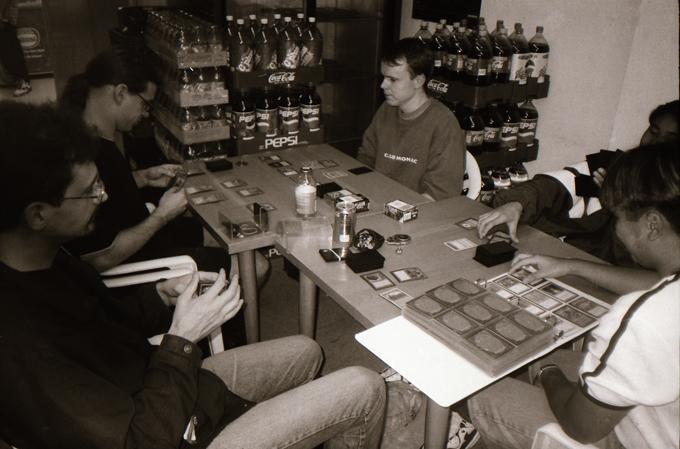By Elias Takacs
Piotr Konieczny barely knew any English when he stepped off Yonge St. into a gathering of Magic players at 401 Convenience.
But after only a few hours in the tiny variety store just north of Ryersno, Konieczny felt quite at home — despite having recently arrived on a visit from Poland.
“I didn’t know anybody here when I came in, and now they’re all my friends,” said the 18-year-old.
Konieczny found his Canadian friends through Magic: The Gathering, a fantasy game played with decks constructed from some 4,000 different cards, in which players become wizards and cast spells to destroy their opponents.
Players use their own decks of lavishly illustrated cards. Each card has a description of a magical action — summoning a fireball, for instance. What kind of spells players can cast depends on the cards they hold.
Introduced in North America in 1994, Magic is now distributed worldwide, in Korean, Japanese, Chinese, French, German, Italian and English. But the rules and rituals of Magic make the game a kind of language in its own right, common to players all over the world.
“It brings people together,” said Konieczny. He said that trying to understand the writing on the cards helped him stay motived during boring English classes in Poland, since Magic is not yet printed in Polish.
“I came here [to 401 Convenience] to play and buy some cards because they are hard to get in Poland,” he said.
There are 70 to 80 people who participate in tournaments at the store, held four times a week. The games attract a diverse crowd.
At age 45, Les Hubbard is one of the older tournament players. A Magic player for nearly four years, he likes the game because it allows for many creative possibilities.
“It’s just so diverse, there are so many possibilities for decks,” said Hubbard. “But I love the artwork and the genre of the game. I always loved fantasy, even as a kid.” The setting for Magic is that of wizards, goblins and enchanted lands.
John Park, owner of 401 Convenience, says that Magic’s appeal comes from its strategic aspect. “It’s a great intellectual game. It’s like chess,” he said.
But it’s an expensive game, since around a dozen of the rarer cards can cost more than $100, and one card, the Black Lotus, has a retail value of $400. Players value these cards for their rarity, but mostly for their power to win games.
Herbert Chung, 21, who recently won a tournament at 401 Convenience, knows all about expensive cards. He won a “Mox Jet” card that afternoon, a card that sells for $135.
Chung keeps another card worth more than $100, “Jester’s Cap,” in his deck as a good luck charm. But luck y may have nothing to do with his success at the game, as he has been a tournament player for nearly three years, and has invested more than $1,000 in his deck of cards.
The game is like a magnet for a variety of people that share the same interest in the game. “It provides escapism,” said Hubabrd.











Leave a Reply